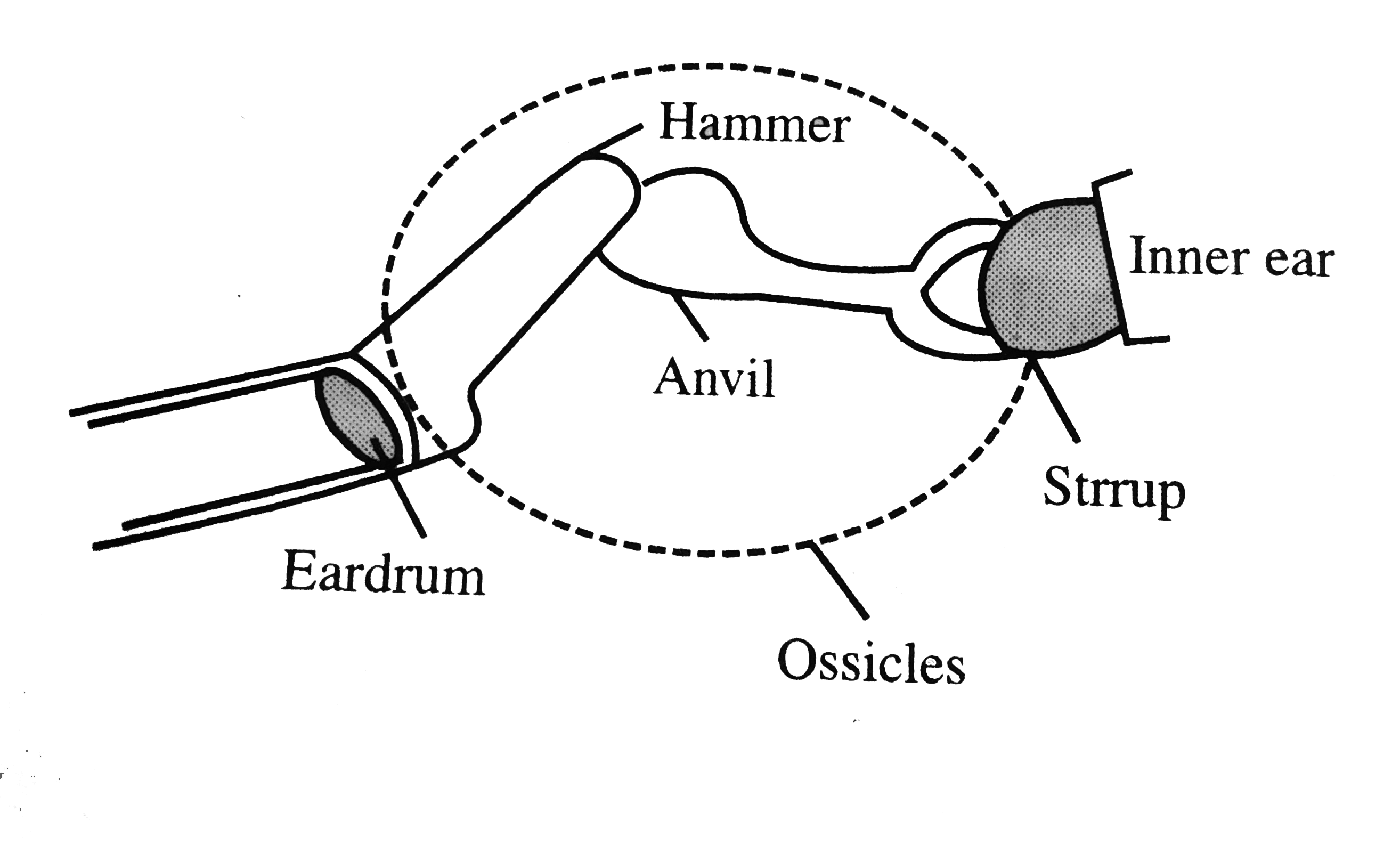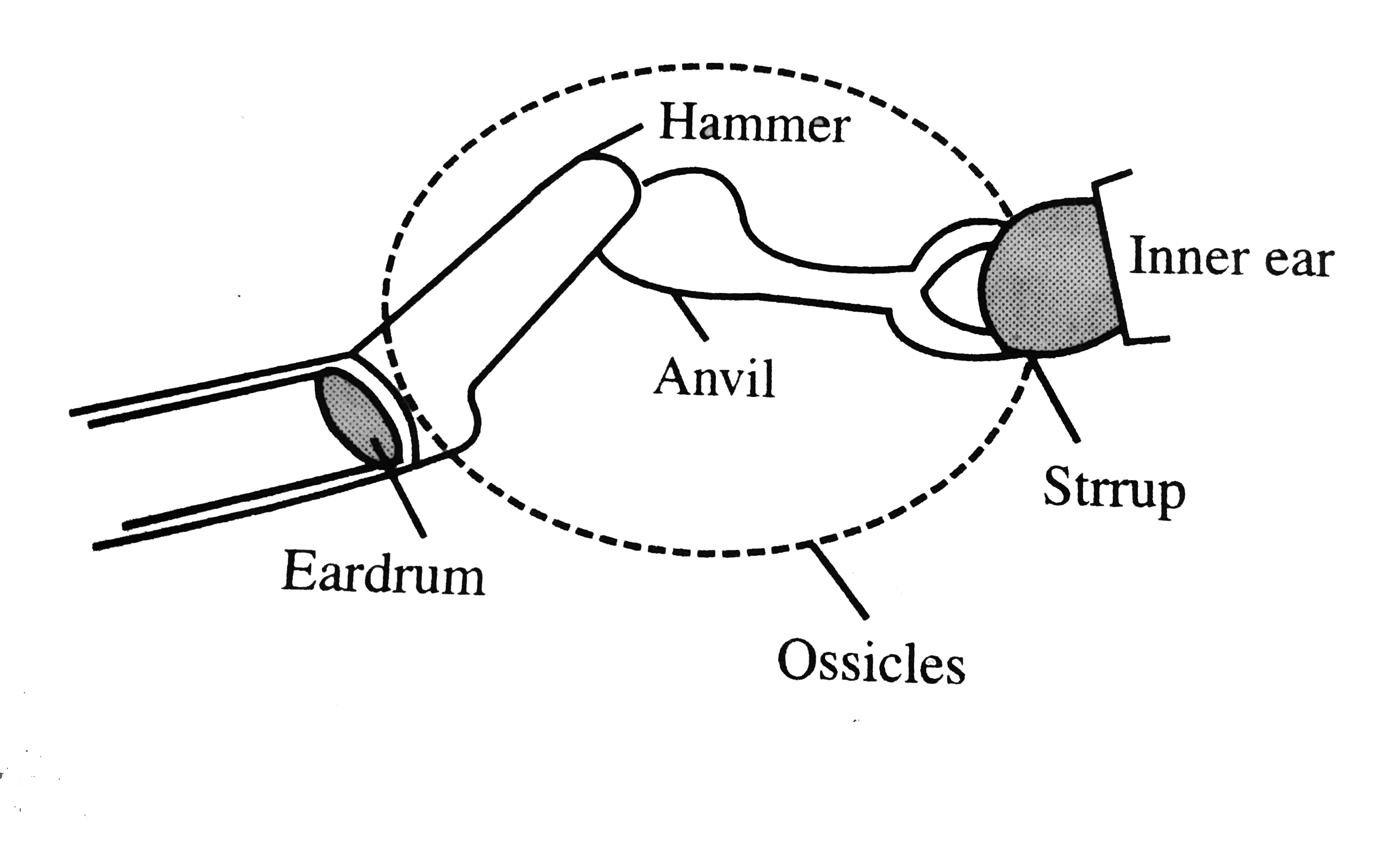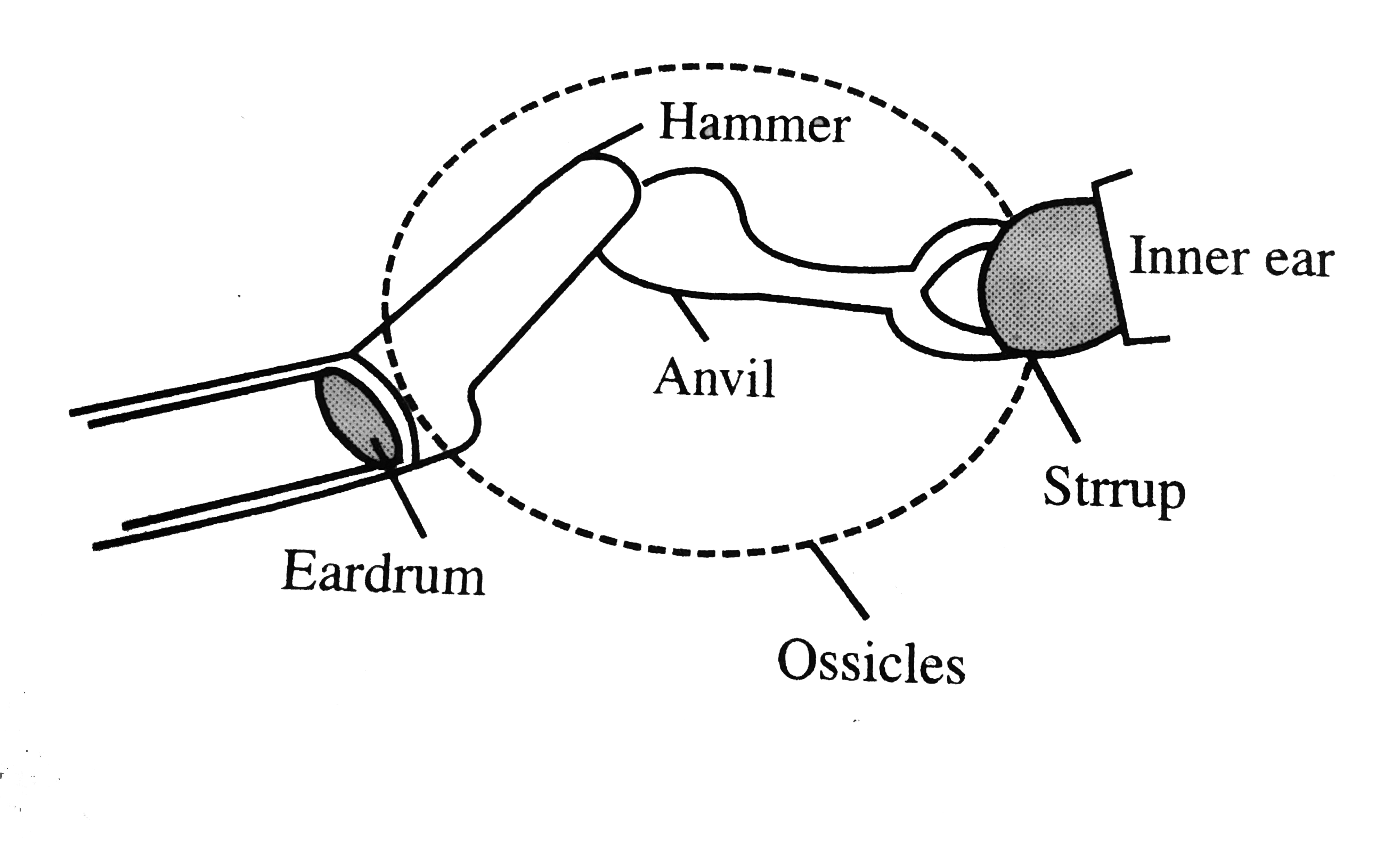[A] : Tympanic membrane stretching across the aperture between skull bones or within an external meatus.
[B]: This vibrates periodically and transmit- ting external air pressure changes to ear os- sicles of middle ear.
If both A and R are true and R is the correct explanation of A
If both A and R are true but R is not the correct explanation of A
If A is true and R is false
If both A and R are false
The correct Answer is:B
Step by step video, text & image solution for [A] : Tympanic membrane stretching across the aperture between skull bones or within an external meatus. [B]: This vibrates periodically and transmit- ting external air pressure changes to ear os- sicles of middle ear. by Biology experts to help you in doubts & scoring excellent marks in Class 12 exams.
Updated on:21/07/2023Topper's Solved these Questions
Similar Questions
Read the passage given below and then answer questions on the basis of your under standing of the passage and the related studied concepts.
Passage:
When a resistor is connected across the terminals of a battery, a current is established in the circuit which has a unique direction going from positive terminal to the negative terminal via the external resistor. Magnitude of the current also remains practically constant. If the direction of the current in a resistor (or any other element) changes alternately, the current is called an alternating current. The alternating current being supplied in our houses varies sinusoidally with time. Such a current repeats its value after a finite time interval T, called the time period. So, the current is positive for one half period and is negative for the remaining half period. In reality it means that direction of current reverses after every half time period.
An alternating current may be expressed asI=Iwsin(ωt+ϕ) where Im is the peak value of current or the current amplitude. The mean current for a period T is definitely zero but mean of I2 over the same period is not zero because I2 is always positve. The average of l2 over a time period T or a long period of time is l2m=l2m2 . The square root of mean square current is called rms current or virtual current and it is given as Irms=Im√2
(b) Two alternating currents are expressed as I1=Imsin(ωt+ϕ) and I2=Imcos(ωt+ϕ). What is the difference between the two currents?
View Solution
When a sound wave enters the ear, it sets the eardrum into oscillation, which in turn causes oscillation of 3 tiny bones in the middle ear called ossicles. This oscillation is finally transmitted to the fluid filled in inner portion of the ear termed as inner ear, the motion of the fluid disturbs hair cells within the inner ear which transmit nerve impulses to the brain with the information that a sound is present. The theree bones present in the middle ear are named as hammer, anvil and stirrup. Out of these the stirrup is the smallest one and this only connects the middle ear to inner ear as shown in the figure below. The area of stirrup and its extent of connection with the inner ear limits the sensitivity of the human ear consider a person's ear whose moving part of the eardrum has an area of about 50mm2 and the area of stirrup is about 5mm2. The mass of ossicles is negligible. As a result, force exerted by sound wave in air on eardum and ossicles is same as the force exerted by ossicles on the inner ear. Consider a sound wave having maximum pressure fluctuation of 4×10−2Pa from its normal equilibrium pressure value which is equal to 105Pa. Frequency of sound wave in air is 332ms. Velocity of sound wave in fluid (present in inner ear) is 1500ms. Bulk modulus of air is 1.42×105Pa. Bulk modulus of fluid is 2.18×109Pa.
Q. If the person is using an hearing aid, which increase the intensity of given sound wave change as perceived by inner ear?
View Solution
Knowledge Check
Assertion. Tympanic membrane separates the external ear from the middle ear.
Reason. Tympanic membrane transmits vibrations (pressures waves in air) to the internal ear via ear ossicles of middle ear.AIf both A and R are true and R is the correct explanation of A.BIf both A and R are true and R is not the correct explanation of A.CIf A is true but R is false.DIf both A and R are false.Mechanism of hearing
i. The external ear receives sound waves and directs them to the ear drum
ii. Nerve impulses are generated in the associated afferent neurons
iii. The waves in the lymphs induce a ripple in the basilar membrane
iv. The vibrations are passed to the fluid of the cochlea, where generate waves in the lymphs.
v. Vibrations are transmitted through the ear ossicles to the oval window
vi. The ear drum vibrates in response to the sound waves.
vii. Impulses are transmitted via auditory nerves to the brain, where the impulses are analysed and the sound is recognised
Choose correct sequence of mechanism of hearing .Ai, ii, iii, iv, v, vi and viiBi, v, iii, iv, ii, vi and viiCi, vi, iv, iii, ii, v and viiDi, vi, v, iv, iii, ii and viiRead the following statements and find out the incorrect statements.
a. Anatomically, the ear can be divided into three major sections called the outer ear, the middle ear and the inner ear.
b. The outer ear consists of the pinna and external auditory meatus (canal).
c. The tympanic membrane (ear drum ) is composed of connective tissue covered with mucus membrane outside and with skin inside.
d. The ear ossicles reduces the efficiency of transmission of sound waves to the inner ear.
e. The pinna collects the vibrations in the air which produce sound.Aa and bBb and cCc and dDd and e

When a sound wave enters the ear, it sets the eardrum into oscillation, which in turn causes oscillation of 3 tiny bones in the middle ear called ossicles. This oscillation is finally transmitted to the fluid filled in inner portion of the ear termed as inner ear, the motion of the fluid disturbs hair cells within the inner ear which transmit nerve impulses to the brain with the information that a sound is present. The theree bones present in the middle ear are named as hammer, anvil and stirrup. Out of these the stirrup is the smallest one and this only connects the middle ear to inner ear as shown in the figure below. The area of stirrup and its extent of connection with the inner ear limits the sensitivity of the human ear consider a person's ear whose moving part of the eardrum has an area of about 50mm2 and the area of stirrup is about 5mm2. The mass of ossicles is negligible. As a result, force exerted by sound wave in air on eardum and ossicles is same as the force exerted by ossicles on the inner ear. Consider a sound wave having maximum pressure fluctuation of 4×10−2Pa from its normal equilibrium pressure value which is equal to 105Pa. Frequency of sound wave in air is 332ms. Velocity of sound wave in fluid (present in inner ear) is 1500ms. Bulk modulus of air is 1.42×105Pa. Bulk modulus of fluid is 2.18×109Pa.
Q. Find the pressure amplitude of given sound wave in the fluid of inner ear.
View Solution
When a sound wave enters the ear, it sets the eardrum into oscillation, which in turn causes oscillation of 3 tiny bones in the middle ear called ossicles. This oscillation is finally transmitted to the fluid filled in inner portion of the ear termed as inner ear, the motion of the fluid disturbs hair cells within the inner ear which transmit nerve impulses to the brain with the information that a sound is present. The three bones present in the middle ear are named as hammer, anvil and stirrup. Out of these the stirrup is the smallest one and this only connects the middle ear to inner ear as shown in the figure below. The area of stirrup and its extent of connection with the inner ear limits the sensitivity of the human ear consider a person's ear whose moving part of the eardrum has an area of about 50mm2 and the area of stirrup is about 5mm2. The mass of ossicles is negligible. As a result, force exerted by sound wave in air on eardrum and ossicles is same as the force exerted by ossicles on the inner ear. Consider a sound wave having maximum pressure fluctuation of 4×10−2Pa from its normal equilibrium pressure value which is equal to 105Pa. Frequency of sound wave in air is 332ms. Velocity of sound wave in fluid (present in inner ear) is 1500ms. Bulk modulus of air is 1.42×105Pa. Bulk modulus of fluid is 2.18×109Pa.
Q. Find the displacement amplitude of given sound wave in the fluid of inner ear.
View Solution
When a sound wave enters the ear, it sets the eardrum into oscillation, which in turn causes oscillation of 3 tiny bones in the middle ear called ossicles. This oscillation is finally transmitted to the fluid filled in inner portion of the ear termed as inner ear, the motion of the fluid disturbs hair cells within the inner ear which transmit nerve impulses to the brain with the information that a sound is present. The theree bones present in the middle ear are named as hammer, anvil and stirrup. Out of these the stirrup is the smallest one and this only connects the middle ear to inner ear as shown in the figure below. The area of stirrup and its extent of connection with the inner ear limits the sensitivity of the human ear consider a person's ear whose moving part of the eardrum has an area of about 50mm2 and the area of stirrup is about 5mm2. The mass of ossicles is negligible. As a result, force exerted by sound wave in air on eardum and ossicles is same as the force exerted by ossicles on the inner ear. Consider a sound wave having maximum pressure fluctuation of 4×10−2Pa from its normal equilibrium pressure value which is equal to 105Pa. Frequency of sound wave in air is 332ms. Velocity of sound wave in fluid (present in inner ear) is 1500ms. Bulk modulus of air is 1.42×105Pa. Bulk modulus of fluid is 2.18×109Pa.
Q. This person (without hearing aid machine) is sitting inside a busy restaurant where average sound intensity is 3.2×10−5Wm2. How much energy in the form of sound is taken up by the person in his meal time of 1 h?
View Solution
When a sound wave enters the ear, it sets the eardrum into oscillation, which in turn causes oscillation of 3 tiny bones in the middle ear called ossicles. This oscillation is finally transmitted to the fluid filled in inner portion of the ear termed as inner ear, the motion of the fluid disturbs hair cells within the inner ear which transmit nerve impulses to the brain with the information that a sound is present. The theree bones present in the middle ear are named as hammer, anvil and stirrup. Out of these the stirrup is the smallest one and this only connects the middle ear to inner ear as shown in the figure below. The area of stirrup and its extent of connection with the inner ear limits the sensitivity of the human ear consider a person's ear whose moving part of the eardrum has an area of about 50mm2 and the area of stirrup is about 5mm2. The mass of ossicles is negligible. As a result, force exerted by sound wave in air on eardum and ossicles is same as the force exerted by ossicles on the inner ear. Consider a sound wave having maximum pressure fluctuation of 4×10−2Pa from its normal equilibrium pressure value which is equal to 105Pa. Frequency of sound wave in air is 332ms. Velocity of sound wave in fluid (present in inner ear) is 1500ms. Bulk modulus of air is 1.42×105Pa. Bulk modulus of fluid is 2.18×109Pa.
Q. With respect to information provided above, mark the correct statement.
View SolutionSelect the incorrect statement
i. Outer ear consists of pinna and external auditory meatus
ii. Auditory meatus extends inwards to tympanic membrane
iii. Meatus possess sweat glands and fine hairs
iv. Tympanic membrane composed of connective tissue covered with skin from inside and muscus membrane outside
View Solution
